- info@aromantique.co.uk
- 07419 777 451
Heather Dawn: Godfrey. P.G.C.E., B.Sc. (Joint Hon)
The prestigious Janey Loves Platinum Awards originated in 2018, and are presented for excellence and innovation for Natural, Organic, and Eco products and services. These Awards present an amazing opportunity, not only to showcase, but also to raise public awareness of the scope of choice and availability of ‘kind to earth’ innovations. In deed, there is something for everyone. These awards demonstrate that we CAN make a difference through the consumer choices we make.
I gain so much more from entering the competition than winning an Award (for which I am, even so, extremely appreciative). Simply through participation, for example, I discover a community of people striving to make a positive difference through their creations, wares and services, some of whom may have remained invisible to me but for me stepping out of my bubble and ‘having a go’. Recent global events will impact our economy in ways yet to unfold. It seems more important than ever to support small innovative business, and each other, to bolster resilience and transfiguration as we positively move forward. We each have something of value to contribute. In this context, competition slides into the background to make way for a shared sense of greater purpose.
The product I offer to this platform is my books.
The objective of my books, Essential Oils for the Whole Body and Essential Oils for Mindfulness and Meditation, is to provide a ‘road map’ to the safe and effective application of essential oils – to support the ‘everyday user’, student and practitioner so they may discover for themselves the many benefits and qualities essential oils gift, and how to apply them confidently, safely, effectively and creatively.
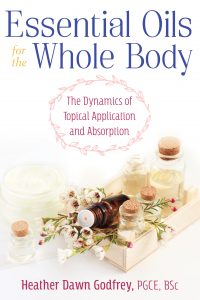

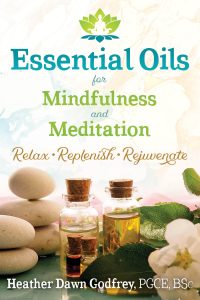

Aromantique as a business incorporates three dynamic strands; professional training, aromatherapy treatments, and related books and publications.
My aromatherapy studio is based in Lyme Regis, the historical sea town nestled on the south Jurassic coast at the border between East Devon and West Dorset. Thus, my clients are a mix of holiday visitors and local residence. I prefer to engage with students in person rather than via ‘virtual’ media, especially as much of what we do involves experiential tasks (for example, it’s impossible to virtually ‘smell’ the scent of an oil, plant or flower).
Essential Oils for Mindfulness and Meditation (Janey Loves 2019 Platinum Awards winner), and Essential Oils for the Whole Body (Janey Loves 2020 Platinum Awards winner) are published by Healing Arts Press Inner Traditions, Vermont USA. – Essential Oils for Mindfulness and Meditation is also published in Traditional Chinese.
As my age determines, I have travelled a long and varied road. I learnt to meditate in the early ‘70’s, when I was a teenager, and, at the same time, serendipitously, was introduced to the tenets of complementary medicine (or alternative medicine as it was coined then). I met and worked for Robert Tisserand during this period, and also met other people who enthusiastically introduced me to acupuncture, homeopathy, and osteopathy; I was young and fascinated, this was a whole new world to me.
Now, I have four lovely grown up children, who now have children of their own! While my children were small, I did various part time jobs that enabled me to juggle being a mother and work to ‘help make ends meet’. For example, I was ‘Arts Coordinator’ for my local Council funded Arts Association, and worked for a T-shirt printing company. I was a parent governor at my children’s schools, and also stood as a candidate for the Green Party during local elections (more of a quest to encourage the other parties to take on green issues in those days, a strategy that did work in part).
As my children began to grow up, I was able to pick up the threads I began to weave earlier and completed a BSc degree in Counselling and Complementary Medicine, then Masters’ modules in Mindfulness, and Supervision of Counselling, at the University of Salford, and a Post Graduate Certificate of Education at Bolton Institute. During this period, I set up my aromatherapy practice. I also taught at various local FE Colleges: subjects included ITEC and VTCT aromatherapy and reflexology, and PTLLS (Preparing to Teach in the Lifelong Learning Sector). I was offered and accepted a post at the University of Salford (School of Health Science and Social Care, now the School of Health and Society) and was Programme Lead for the B.Sc. Integrated Therapy in Practice degree, Module Lead for Aromatherapy, and Supervision and CPD, and Personal Tutor (among other roles). I worked there for a number of years as part of a team delivering degrees that straddled Complementary Medicine, Health Sciences and Counselling. My specific interest was, and still is, the psycho-emotional influence of essential oils in terms of maintaining health and wellbeing (my original dissertation explored The Role of Essential Oils in the Management and Treatment of ADHD and my Masters assignment explored Essential Oils and Mindfulness. and Supervision of Counselling).
My books are an accumulation of my years spent studying, teaching and working in this field. Essential oils embrace so many dynamics – creative, artistic, sensual, emotional, healing and nurturing, and have led me to delve into aspects I might otherwise have shied away from – organic chemistry, botany, pathophysiology – but which I find fascinating (jigsaw pieces in an intriguing landscape), so I am grateful for the nudge. I am, in this respect, a perpetual student – the adage ‘the more you learn, the less you know’ seems so true, learning seems a constantly unfolding process as one insight leads to another, then another and another.
I moved from Lancashire to Dorset nearly seven years ago (my children adults, with families of their own), settling in Lyme Regis. The West Country is where the roots of my extended family evolved (dad, a ‘Devon lad’ joined in the RAF as a teenager, met my mother, ‘a Dorset girl’, and my brother, sister and I spent our childhood and teenage years travelling with our parents wherever dad was posted). Lyme Regis sits neatly between both counties.
It’s a no-brainer. It’s impossible to be involved in the field of integrated medicine and therapies and not realise the intrinsic connection we have with our environment and nature; that everything is, in fact, interconnected; that we are influenced by what we eat and consume in various ways; and that we, in turn, influence the environment around us through our actions and behaviours. We are part of, not separate from, nature; we are dependent – for example, even the slightest change in levels of oxygen in the atmosphere would end our existence; our bodies cannot function without the nutritional input gifted by nature. Experiencing respect and reverence is as important to our souls as feeling unconditional love – both states or conditions, in fact, expressions of that love.
I chose my publisher, Inner Traditions, not just because of their prestigious professional reputation or that they publish books in my genre, but also because they uphold ‘green’ values (for example, see https://www.innertraditions.com/greenpolicies).
Equally, I select suppliers whose oils and products are ethically sourced and, as often as possible, organic, especially my essential oils (for example, NHR Organic Oils , Oshadhi UK (among others). All -be-it ‘out there’, there is something about the energy and therapeutic quality of oils that are appropriately, respectfully sourced and distilled; sustainably grown and harvested plant material and appropriate length of distillation time and temperature are significant determinants of quality of resultant essential oils. Ensuring this quality sometimes means paying a little more for the oils, but if that payment supports this practice and finds it’s way back down the chain in fair remuneration to everyone involved, so we are all able to positively support each other, then so-be-it; quality and reliability are paramount with regard to my therapeutic practice.
My feeling is not to compete, but rather to focus on doing what I do well. I meet so many amazing people on my journey, and we learn so much from each other; each of us has a special gift to share and express which lends itself to the ‘bigger picture’ and scheme of things. I am fascinated and inspired by essential oils and by the way essential oils influence both physical and subtle elements (body and soul) at one and the same time, and how these dynamics influence mood, emotion, and body.
Essential Oils for the Whole Body provides a broad platform that enables the reader to ‘get started’. It is a ‘one stop’ go-to handbook that takes the reader through both the practical and subtle applications of essential oils. Tapping into the creativity and sensuality of essential oils, embracing dynamics such as colour and gemstones is useful but also fun. However, I ensure that I do not trivialise their inclusion, nor trivialise the application of essential oils. I have observed that when applied appropriately, a subtle dynamical approach can actually be very effective.
The boundaries between physical, psychological and emotional (body, mind, and spirit) often overlap. Indeed, feeling happy, relaxed and calm, positive and optimistic, demonstrably influences physical function; heart rate, blood pressure, cortisol levels, endorphin release, digestion, ability to heal, and so on. Therefore, a significant aspect of our wellbeing, immunological support and healthy function, is influenced by our state of ‘being’ – ‘being in stress’ or ‘being in equanimity’, ‘being in fear’ or ‘being in peace’. Indeed, we are often reminded that unconditional ‘love’ is an optimum state of ‘being’. Our state of ‘being’ influences our state of ‘body’. It is in this context that essential oils find a perfect niche, as they are shown to influence all of these dynamics at one and the same time.
Also, through experience, I have come across situations in which essential oils, while potentially being extremely valuable, are also potentially contra-indicated because of serious underlying health conditions and/or medications being taken by a person (some essential oils can negatively potentiate certain medications, negate others, or increase risk of sensitisation). This is why Essential Oils for the Whole Body includes a basic overview of physiology, with information about how essential oils are absorbed and excreted by the body, which oils are not safe to use in certain contexts and which are safe, and how to apply essential oils appropriately. Anchored by this understanding, ways in which essential oils can be applied subtly with minimal risk are explored – that is, highly diluted, with just a hint of scent (olfactory receptors can detect very small amounts of essential oil molecules), perhaps applied alongside colour and gemstones to gently support the subtle dynamics of each.
At my age, to fulfil the typical cliché, my big dream is a cottage , flowers around the door, with a lovely big kitchen and a massive garden where I can grow things and distil essential oils, and, of course, live happily ever after!! Meanwhile, back in the real world (while I wait to meet this dream) to continue to write and share through teaching; that all my books are successfully published (in fact, this dream has already come true); that I have sufficient funds so can spend less time working and can afford time to delve into my other passions, for example, art (I love drawing, photography, and creativity) and to explore and continue to appreciate the world around me. I do not envisage that I will stop working because I love what I do – I have a feeling, though, something amazing is going to happen that I have not envisaged, because each day is a unique moment full of both imagined and unimagined of possibility.
Heather is a very talented and experienced aromatherapist, she intuitively blended a sublime mix of oils specifically for me and gave an amazing massage. I left with both my body and mind relaxed and rejuvenated. An absolutely delightful experience, thank you Heather.
Jess B.
Wow! Went to Heather for a massage last week. It was an amazing experience, incredibly relaxing, and very healing. Heather is incredibly professional, whilst at the same time, extremely warm and welcoming, instantly putting you at ease. The treatment took place in her studio, which is warm, cosy and peaceful. A full body massage is just that and I felt that every part of my body benefited from the gentle massage using the essential oils that Heather and I chose together. By the end of the session I felt as though I had been wrapped in a little cocoon and was very reluctant to leave! Have already booked my next treatment. Thank you so much, Heather. I shall be recommending you to all my friends x
Clare S.
 Essential Oils for the Whole Body
Essential Oils for the Whole Body
An impressive and comprehensive presentation of what essential oils are, how they work, and how to use them, not only for physical illnesses but also on the psycho-emotional level. A great book on essential oils!
Christopher Vasey, ND, author of Natural Antibiotics and Antivirals
In times when most aromatherapists are going back to using simple recipes based on the biomedical paradigm, this book opens up another way of looking at topical applications and absorption dynamics. These areas are actually more complex than mechanical interpretation allows and require a book with a holistic, and even spiritual, background combined with scientific insight. It will surely build stronger relationships with the ‘whole body’.
Martin Henglein, Naturopath, Aromatherapist, and Osmologist
This book offers a beautiful bridge between the science of aromatherapy and esoteric application. Godfrey presents a truly holistic approach that explores how to support the whole self, from the physical to the emotional and spiritual.
Candice Covington, author of Essential Oils in Spiritual Practice
A lovely book packed full of information about the form and function of the human body and the ways essential oils can interact with it. This book builds on the author’s previous work, Essential Oils for Mindfulness and Meditation, to create an invaluable guide for those who wish to understand essential oils and use them creatively and safely.
Sophie (Petit-Zeman) Olszowski, Ph.D Author of Doctor, What’s Wrong? Making the NHS Human Again, and Editor, NHS Researcher, and Director of SPZ Associates Ltd
I am an avid believer in using essential oils in many different aspects of body health and home use so I was thrilled to receive this book for review. What I found here is a great complete education on Essential Oi . The author has included blending of oils, safety as well as even the chemical contents, which are good to know for those of us that use oils in our daily lives. I highly recommend the instructions for making creams, ointments and skin care product’s, which was so fun to learn so much more then I knew. The recipes are brilliant and easy to follow. There is also information on diffusing oil’s, which I am already using and enjoying. A ‘definitive’ book on essential oils this book I highly recommend for all who use oils and wish to educate themselves on both the oils, the process and the creation of recipes. Out of all the books on Essential Oils I have read over the years this is my favourite.
C.C. Netgalley
The content of this book is full of very descriptive information about essential oils. It would make a great reference book in any home as well as the local public library. This book would also be a well-used addition to any person wanting a more in-depth knowledge of oils. It will also help those like me who dally somewhat with oils but do not fully comprehend all the intricacies. Might keep someone like me from handling the oils improperly.
Mary. Goodreads
This book is a great resource for anyone wanting to dig deeper into essentials oils, you get tons and I mean tons of resourceful information I cannot express how much detail and research this author did just for this book. You get recipes, for creams, lotions, and perfume oils. The author doesn’t only use essential oil, but she also gives you a list of gemstones to use every day, you get worksheets and much more to help you in your study and lifestyle.
Laurie. Goodreads.
 Essential Oils for Mindfulness and Meditation
Essential Oils for Mindfulness and Meditation
There is a unique way to enhance psychological well-being waiting to be explored. This book tells you how meditation and aromatherapy, classic tools for modifying the mind, can work together to maintain a state of calm and insight. Familiar oils like rose and frankincense add serenity and inspiration to the practice of mindfulness meditation. Diffusing an essential oil during meditation practice can even return your awareness to that meditative mode if you smell the aromatic oil again later.
The author is an aromatherapist who not only uses essential oils professionally but also conducts research into the effects of these powerful plant ingredients. The reader will find out how knowledge of traditional practice and subjective experience, backed by scientific evidence, is an ideal path for discovery; how mindfulness meditation and essential oil inhalation relieve anxiety or calm the mind, as explained from the perspectives of ancient history, religious practices, and modern complementary medical practice. Scientific studies involving human subjects and essential oils tested in laboratory models are described in easy-to-digest detail that adds value and validity.
Advice on how to use the pure essential oils comes with a thorough briefing on dose and safety–a prerequisite for these concentrated and potent plant extracts. In passing, learning about the many everyday food, drink, and cosmetic products that contain essential oils is an eye-opener on the hidden influences on the mind and body. This book is bound to have a long-lasting impact on both meditation and aromatherapy practices, thanks to its inspired author, Heather Dawn Godfrey.
Elaine Perry, Ph.D., professor emeritus of neuroscience at Newcastle University and co-author of Your Brain on Plants: improve the way your think and feel
Essential Oils for Mindfulness and Meditation fills an important gap in the field of essential oils. Where many other books are contented with the properties and the handling of oils, Heather Godfrey provides us with a profound scientific background of the different oils and opens up the field toward awareness and meditation. This book is a wonderful guide to using essential oils as valuable helpers for everyday life, as a source of knowledge for well-being professionals, and for a deeper understanding of oneself and nature.
Ewald Kliegel, author of Crystal Wands and Holistic Reflexology
This interesting book melds the science and alchemy of essential oils and their use in meditation with a mix of personal anecdotes and evidence. Taking the reader on a journey through these highly topical disciplines, it is a timely reminder and how-to guide of the importance of stepping back from the maelstrom of modern life to find a sensible inner balance.
Sophie (Petit-Zeman) Olszowski, Ph.D Author of Doctor, What’s Wrong? Making the NHS Human Again, and Editor, NHS Researcher, and Director of SPZ Associates Ltd
This book is an impressive and comprehensive presentation of what are essential oils, how they work and how to use them, not only for physical illnesses, but also on the psycho-emotional level. A great book on essential oils!
Richard Vasey Author of Natural Antibiotics and Antivirals
Godfrey, an International Federation of Aromatherapists fellow, skilfully explains how scent works on the brain to create relaxation and how this affects our well-being. Odors that stimulate brain chemicals, such as serotonin and GABA, trigger composure, concentration, deep breathing, and a meditative state to reduce stress and anxiety. Research is presented on rehabilitative techniques to remove negative emotional states, like regrets, traumas, fears, and anxiety. Charts and discussion show the brain’s hemispheres and the actions of a few essential oils are mentioned, although no recipes are suggested. There are also guidelines for use, healthy foods, and methods, techniques, and tools for application.
American Herb Association Quarterly
This book is an informative guide to the use of essential oils as an accompaniment to meditation/mindfulness. It finishes with a chapter on other forms of achieving wellbeing – nutrition, exercise and relaxation. There are footnotes and a bibliography for further information. As such it’s very comprehensive but as a newcomer to essential oils I didn’t find the content intimidating.
Tina. Goodreads
A great guide for beginners wanting to learn more about mindfulness and meditation and how to use essential oils for relaxation. A good reference book to have on hand with well organised tables for easy access to information. Great background information on mindfulness and using essential oils for those that are just starting out.
Kat. Goodreads
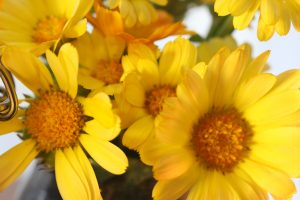
Heather Dawn: Godfrey. P.G.C.E., B.Sc. (Joint Hon)
This article explores ways in which to support your immune system, and describes how essential oils can play a significant role.
For in-depth detail about the properties and qualities of essential oils and how to apply them safely and effectively, please refer to my books, Healing with Essential Oils, Essential Oils for the Whole Body and Essential Oils for Mindfulness and Meditation.
The article below includes excerpts from my new book, Healing with Essential Oils (working title), which is due to be published by Healing Arts Press, Inner Traditions, winter/spring 2022.
We have an intrinsic symbiotic and mutualistic relationship with plants. At the very least we depend on them to maintain the correct atmospheric gaseous balance between oxygen and carbon dioxide. They provide vital nutrients, including minerals, medicines, and energy from the biosynthesis of carbohydrates; they nourish, heal and vitalise. Fibrous plants provide materials for crafting clothes, tools and implements. And so on.
Not all plants contain essential oils, and not all essential oil containing plants are safe to consume.
Essential oils occur in plants as secondary metabolites. They are not vital to the plants existence, yet they play a significant supporting role. For example, essential oils exude volatile chemicals as a vaporous haze around the plant to ward off and protect the plant from predators and harmful microbes, and attract pollinators such as bees, butterflies, birds, and animals. This haze also reduces water loss, and relays signals to other similar plants. Within the plant essential oils behave like hormones, relaying messages in response to changes in atmospheric conditions, tissue injury, damage or disease, and invasive microbes, among other things. Essential also possess anti-microbial properties that help stave off infection and disease, and also have tissue-regenerating properties.
Just as within the plant, essential oils are not vital to our existence, yet gift us similar protective, restorative and regenerative properties.
Like a lock for a key, olfactory receptors detect volatile scent molecules and relay neural signals to the brain. Receptors are found not only in the nasal cavities, but also in other tissues and organs throughout the body, including the skin. Neural signals reach the Limbic System (the instinctive and emotional centre of the brain), which is connected, via the hypothalamus, to the pituitary gland (the master endocrine gland) and the frontal lobe of the brain (where we rationalise and make sense of information). Essential oils, thus, influence mood and emotion, aid memory, concentration, invoke mental alertness, stimulate hormone release, and more. Their molecules also rejuvenate and heal soft tissue. They aid metabolic function. They are adaptogenic (that is, they tend to target their actions according to need). They are restorative and protective. They support the immune system.
The human microbiome, just like a plants microbiome, consists of trillions of microbes, including viruses, bacteria and fungi, which symbiotically live in and on the body – on the skin, in the gut, and in cavities such as the mouth, ears and vagina – and within an auric-like cloud surrounding the body. The micro biome plays a significant role in protecting and maintaining immunity, and aids a number of vital bodily functions: for example, assisting the breakdown and synthesis of nutrients in the gut and aiding their appropriate absorption, and providing a protective barrier against invasion or proliferation of harmful microbes and pathogens, and more. We coexist with microorganisms; our body houses, feeds, and depends on their presence to maintain functional equilibrium. Poor diet, sugary refined foods, overuse of antibiotics and pharmaceutical drugs, stress and illness, among other factors, can disrupt the harmonious balance of the micro biome, and thus, increase our susceptibility to pathogenic invasion, disease and dysfunction.
Our first line of defence, when considering immunity, is to support our micro biome’s equilibrium (and thus also our health and vitality through optimum absorption, nourishment and resistance): for example, eating nutritionally rich, fresh, seasonal, unrefined, organic whole foods, especially green vegetables, fruits, nuts, beans and other legumes, fermented foods, and so on; drinking plenty of water to hydrate and oxygenate our cells, and flush out waste material from our system; also, fresh air, sunlight (photochemical formation of vitamin D), walking (movement and motion) and gentle exercise (to stimulate peristalsis in the gut, and stimulate the lymphatic system, to remove waste products efficiently from our body). A plants micro biome can also feed ours, hence the advisability of leaving the skin on organic vegetables and fruits, and eating these raw or just lightly cooked.
Our body, according to Tisserand (2020), is biologically programmed to react to essential oil constituents. Essential oil molecules interact with a variety of receptor sites, neurochemicals and enzymes, thus affording potential for therapeutic activity. In deed, the therapeutic action of essential oils is well evidenced, particularly in relation to pain management, wound healing, microbial staving, also anxiety, depression, agitation, insomnia, alertness and cognitive function.
The boundaries between physical, psychological and emotional (body, mind, and spirit) often overlap, as essential oils are shown to influence these both independently and together. Indeed, feeling happy, relaxed and calm, positive and optimistic demonstrably influences physical function; heart rate, blood pressure, cortisol levels, endorphin release, digestion, and so on. Therefore, our second line of defence, in terms of immunological support and healthy function, is our state of ‘being’ – ‘being in stress’ or ‘being in equanimity’, ‘being in fear’ or ‘being in peace’. Indeed, we are often reminded that unconditional ‘love’ is an optimum state of ‘being’. Our state of ‘being’ influences our state of ‘body’.
Hygiene, of course, is another line of defence. That is cleanliness, soap and water, rather than obsessive sterilisation. Observation of our microbiome, as already established, demonstrates that microbial co-existence is the background reality; far from being harmful, we actually thrive in their presence (as explained above) – our microbiome plays a significant role in fighting invading pathogens. There are times, though, when our natural defence mechanisms are compromised, perhaps through illness, stress, shock, anxiety, poor diet, lack of sufficient sleep, among other reasons, and this is when essential oils may ‘come into their own’ as supporting agents.
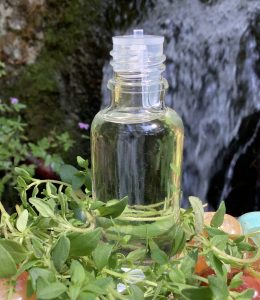 What are essential oils?
What are essential oils?
Essential oils comprise of a concentrated mixture of up to two-hundred-and-fifty or so organic terpene (hydrocarbon) and terpinoid compounds (terpinoids are oxygenated hydrocarbons). Oxygenated compounds are grouped with other similar compounds according to their chemical structures and oxidising behaviours and classified collectively as a functional group: for example, alcohols, phenols, aldehydes, ketones, oxides, esters and ethers. Taken as a whole, though, all compounds in an essential oil contribute to its synergistic quality and therapeutic value. Knowing which functional group(s) predominates, however, provides a useful initial guide when determining potential therapeutic actions, scent profiles, hazards and contra-indications.
For example, lemongrass essential oil comprises of a large proportion of aldehydes (71%) – geranial (41%) and neral (30%) – and a small amount of limonene (0.28%), a monoterpene, among other compounds. Aldehydes are anti-infectious, anti-inflammatory, anti-fungal, and calming to the nervous system. Yet they are very reactive and readily oxidise to form organic acids: rendering them skin irritants and sensitisers, especially if they are not stored appropriately. In terms of scent profile, geranial has a light sharp, fresh odour, characteristic of lemon. Neral has a light, sharp odour, somewhat less fresh than geranial. Limonene has a lemony sometimes turpentine-like odour. As a whole, including the remaining smaller compounds not identified previously, the odour of lemongrass is described as being fresh, citrus, slightly oily; with strong, lemony, herbal, green, tea-like body notes; and herbaceous somewhat oily dry-out notes (Williams 2006).
The Antimicrobial Qualities of Essential Oils
Essential oils are (with varying degrees of strength depending on the presence and combination of chemicals in their mix) generally anti-viral, anti-bacterial, anti-fungal, anti-inflammatory, and mucolyptic. They can be applied to prevent and stave the spread of infection, and ease symptoms, such as pain, digestive upset and headaches, cold and ‘flu-like’ symptoms, and to treat skin conditions. Even when applied in very small amounts, essential oils may ease psycho-emotional conditions (low mood, anxiety, brain fog, etc.), minor infections (coughs, colds, insect bites) and skin conditions (cuts, grazes, eczema, dry skin, etc.). It is advisable to seek medical advice before self-treating acute, potentially infectious conditions, such as influenza, or other viral conditions, or conditions of which you are unsure of.
A large quantity of essential oil is required to fumigate an environment (at least 30 drops depending on the size of the space); this is best done when no one is in the room to avoid irritation (eyes, nose, throat and lungs). To fumigate safely and efficiently, close all doors and windows to contain the essential oil infused vapours, and diffuse for 30 minutes. Leave the room during fumigation. Once fumigation is complete, open windows and doors to allow an inflow of fresh air to clear residual vapours.
Dried herbs, such as sage, rosemary, and juniper can be used instead of essential oils – these are usually ‘smoked or smudged’, that is, smouldered, to cleanse the atmosphere of pathogens.
Essential Oils that are strongly anti-microbial
Please note that some of the essential oils listed below are strong irritants and sensitisers Always check the qualities and contra indications of an essential oil before applying it, and do not diffuse essential oils near the head-space of infants (who are more easily prone to respiratory irritation).
Apply 2-3 drops on a tissue and inhaled, 2-4 drops in steam inhalation, 2-4 drops in 10ml of carrier medium (vegetable oil, non-perfumed, lotion, cream, or aqueous gel) for skin application – do not use these oils or blends of these oils neat on skin or in the bath.
Cinnamon bark
Clove bud/leaf
Eucalyptus blue gum / radiate / globulus
Tea tree
Thyme red
Geranium bourbon/rose
Lavender
Lemon
Scotch Pine
These are but a few popular examples. For more essential oils and further information about the antimicrobial properties of essential oils, please refer to my book, Healing with Essential Oils (Inner Traditions, Bear and Co.)
Guidelines for safe use
If essential oils are used frequently, for whatever reason (in beauty products, as perfumes, for minor conditions, for relaxation, and so on), then regularly change the oil or blend of essential oils you use (there are numerous essential oils with similar qualities, so alternatives are available) and have a break from use every so often. This will reduce the risk of sensitisation.
Add up to 15 to 20 drops of essential oil to a hand sanitizer (non-perfumed liquid soap dispenser). Do not add essential oils to an antibacterial sanitizer or pre-scented sanitizer (it is not necessary, and avoids risk of irritation). Soap, itself, is antibacterial – soap and water (careful hand washing and drying) are usually sufficiently effective.
Do not diffuse irritating essential oils in public spaces or too close to other people. Always dilute essential oils in an emollient (for example, vegetable oil, cream or lotion) when applying them to skin.
Regularly change the essential oil, or the combination of essential oils, applied in a blend, to avoid sensitisation (as previously mentioned). Do not take these or any essential oils internally (unless under specific professional medical or healthcare supervision). Babies, children, people who are asthmatic or have other pre-existing respiratory conditions, or very elderly or frail, are especially vulnerable in terms of sensitisation and potential irritancy of their airways when exposed to essential oil vapours.
Essential oils and sustainability
Purchase essential oils from suppliers who obtain their oils from sustainable sources.
Due to increased popularity, the market potential of essential oils has increased exponentially in recent years. This increases propensity for product abuse. A pure essential oil is the unadulterated product of extraction, nothing more, nothing less. A good supplier will provide certified evidence of an essential oils origin and chemical composition, and will verify that their oils are derived from a sustainable source.
Summary
Applied appropriately, essential oils are ‘scentually’ very pleasant, safe and incredibly versatile with regard to their therapeutic actions (for example, anti-microbial, skin care and tissue regeneration, psycho-emotional, and more). They are valued for their preventative and supportive properties (for example, anti-inflammatory and tissue regeneration), and may be useful during the early stages of an infection. However, although some essential oils posses a broad spectrum of anti-microbial and antibiotic-like qualities and actions, others are more specific and/or have weaker strength and potency. A clear understanding of an essential oils individual anti-microbial components and the nature of pathogens and how these infiltrate the body, is required to target essential oils effectively and safely. If symptoms are persistent, unexplained, or you feel generally unwell, you are advised to seek medical advice from a certified healthcare professional.
References
Author bio
Heather was introduced to essential oils, alongside other integrated therapy principles and practices, in the early 70’s. She later studied at the University of Salford, gaining a BSc (Joint Hon) Degree in Counselling and Complementary Medicine, and post-graduate Masters Certificates in Integrated Mindfulness, and Supervision of Counsellors, and a Post Graduate Teaching Certificate (PGCE) (Bolton Institute).
Heather taught for several years at the University of Salford in the School of Health Sciences and Social Care.
Relocating from Lancashire to Dorset a few years ago, Heather continues to run a private aromatherapy clinic, and teaches essential oil related courses and workshops.
Healing with Essential Oils (published by Healing Arts Press, Inner Traditions Bear & Com, Vermont USA)
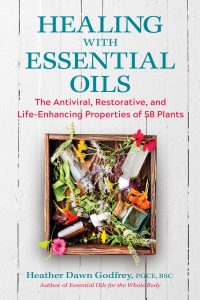
Essential Oils for Mindfulness and Meditation (published by Healing Arts Press, Inner Traditions, Bear & Co., Vermont USA)

Essential Oils for the Whole Body (published by Healing Arts Press, Inner Traditions, Bear & Co., Vermont USA)
